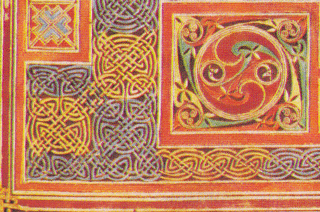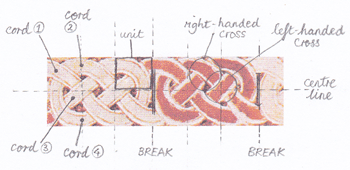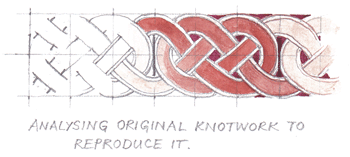Celtic knot designs

Celtic knot designs, or ‘interlace’ as they are also known, are beautiful examples of eye-trickery based originally on the form of a plait and constructed using very simple geometry (it can be done by eye alone, as in the video below).
These uniquely flowing patterns seem to have originated thousands of years ago with the tribes who came to inhabit Britain before the arrival of the Romans and, later, Anglo-Saxons. These earlier, Celtic tribes developed the elaborate ‘woven’ patterns which we now see in museums as decorative elements on surviving objects such as shields, cauldrons, Celtic stone crosses etc.
This video gives an overview of how to construct a simple, quick knotwork heart, or tulip (both forwards and backwards!)
If you enjoy it and you would like to help me make more content on the site, please consider donating a coffee (or however much you want) using the button below.
The Celts' astonishing patterns survived through the Roman and Anglo-Saxon invasions of the British Isles, and through huge changes in culture. By the fifth century AD, very similar Celtic knot designs were still known and used in the British Isles. And sometime before AD700, knotwork designs were adapted to ornament the astonishingly elaborate, luminous carpet pages and decorated initial letters in Irish Christian and other manuscripts – most famously, the Book of Kells and the Lindisfarne Gospels (as illustrated above).
What is so special about Celtic knot designs?
The mystery of Celtic knot designs, and interlace in general, lies in the seamless perfection of the finished item, which both baffles and delights the eye and mind with its precisely interwoven forms and exuberant colour. “How on earth,” one wonders, peering at the elaborate detail, “did they manage to do all that with just one line?”

This is one of the most intriguing features of many Celtic knots; starting at any point, you can follow the thread all the way over and under, up and down, back and forth, right round the design to come back to where you started. It is a lovely metaphor for variety in unity.
It's also an incredibly useful design feature for frames and letter fills.
There is quite a lot of theory out there as to how first the Celts, and then the gospel-decorating monks, actually laid out the grids and lines to build up the complex, symmetrical patterns of their carpet pages and huge, flowing letterforms. Did they draw hundreds of little boxes first? Did they work round dots? Did they use just a few small lines, and were capable of visualising the final result so clearly that they painted the final design almost freehand? Or did they laboriously draw all the details in the faintest of greys and then very studiously colour it all in?

Judging by the number of experts who've published different theories about how Celtic knot designs were originally done, it seems almost certain that different techniques must have arisen in the various scriptoria among different illustrators. So I say, once you've looked at the theories on offer, you should feel totally free to either follow them if they work for you, or develop your own. It's not 'whether you're doing it right' – it's whether it gets the result you want.
I've developed a method that's particularly useful for creating decorative borders, and that can also be adapted to create infill for large, decorative initials. These are the two main uses to which I put Celtic knot designs.
Celtic knot designs – ‘knot’ as hard as they look!
O.K., I apologise for that bad pun. But it’s true that the basic ability to draw a Celtic knot design, like knowing how to write a sonnet, has less to do with inborn talent than with understanding the underlying principles and practising the skills. With not too much effort, therefore, you can both grasp the essentials of how any Celtic knot has been designed and also start creating your own interlace patterns.
So stop wondering and have a go – here are some Celtic knot design how-to pages.
Time to think
Like the Irish monks, all you then need is a little time.
Granted, the ambitious complexity of the Celtic knot designs in the great manuscripts sets a standard of patience that most of us can only envy – while carefully proportioned mathematical structures do underlie the fabulous panels of knotwork which decorate the carpet pages.
However, depending on how many hours you wish to invest, you can create any number of extraordinarily elaborate and complex ‘knotted’ designs in a traditional Celtic style. And although you can use advanced geometry if you want, you really only need freehand squares and circles.
How much time is enough? Well – half-hours, hours, days or weeks! It comes down to how large your design is, and how quickly you can draw tiny lines and colour in tiny boxes.
Like calligraphy itself, though, the benefits of drawing interlace are not restricted to the final product.
As you design and draw your Celtic knots, you may find the process to be a similarly relaxing, almost meditative activity in which alertness and creativity combine with simple repetitive movements. It’s a good time to set the world aside and let your mind unhurriedly put its affairs in order.
But, if you are in a rush, bear in mind that scanners and image software make it easier to manipulate and reproduce sections of interlace quickly. And any time invested is well repaid if you keep a master-file of your finished Celtic knot designs which you can then use over and over for later pieces.
Other traditions of knotwork on the calligraphic page
In fact, knot patterns and interlace of one kind or another are not restricted to the Gaelic Celts or the early medieval period. Such designs decorate many other artefacts and illuminated pages both on the Continent and in later ages. Often, they accompany beautiful calligraphy. Perhaps their latest flowering before modern times in Europe was the white-vine decoration beloved by Italian Renaissance bookmakers as a border for the period’s exquisitely clear humanistic script.
Islamic art, especially, has a long and parallel tradition of geometrical knotted patterns as part of architecture, metal decoration, carpet pattern pages in books, and other ornament. In the Islamic tradition, as in the Celtic, knotwork designs find a kind of culmination in illuminated manuscripts of sacred texts.
Celtic knotwork designs: bibliographical note for those interested
There are several, only somewhat differing methods which can be used to construct Celtic knot designs and related patterns. All of them are based on a grid layout and ways of placing diagonal lines. I don’t go into all the methods here: it’s a big subject with its own specializations and theories and I don’t claim to be an expert. Like anything else on this site, I’ve presented what seem to me to be the most immediately workable methods for the needs of an amateur calligrapher.
However, everyone’s eyes and minds work differently and if you don’t find that the methods outlined on these pages are sympathetic to your own way of working, you might like to study from some of the excellent books available on the subject.
(Where possible, I've provided links to the titles in Amazon.com ... I'm working on links to Amazon.co.uk for my UK visitors! Any proceeds will go towards site upkeep. Don't forget to check the 'used' section for bargains -- I do.)
I also found that MacKinder’s methods build usefully onto Meehan’s. They go into more depth without going over my head, and give me a better understanding of how the knots are constructed. Like Meehan, MacKinder has presented his whole book as a calligraphic work, written in a narrow but handsome quasi-Carolingian roundhand.
Other works are available, and it is also very useful to possess at least a few facsimile pages of the original masterpieces from Kells, Lindisfarne and Durrow so that you have an idea of the tradition in which you’re working. Apart from anything else, they will encourage you to use a palette of softly variegated colours to balance the absolute geometry which characterises Celtic knotwork designs.
Go to the first page of 'How to draw Celtic knots'
Return from 'Celtic knot designs' to the homepage